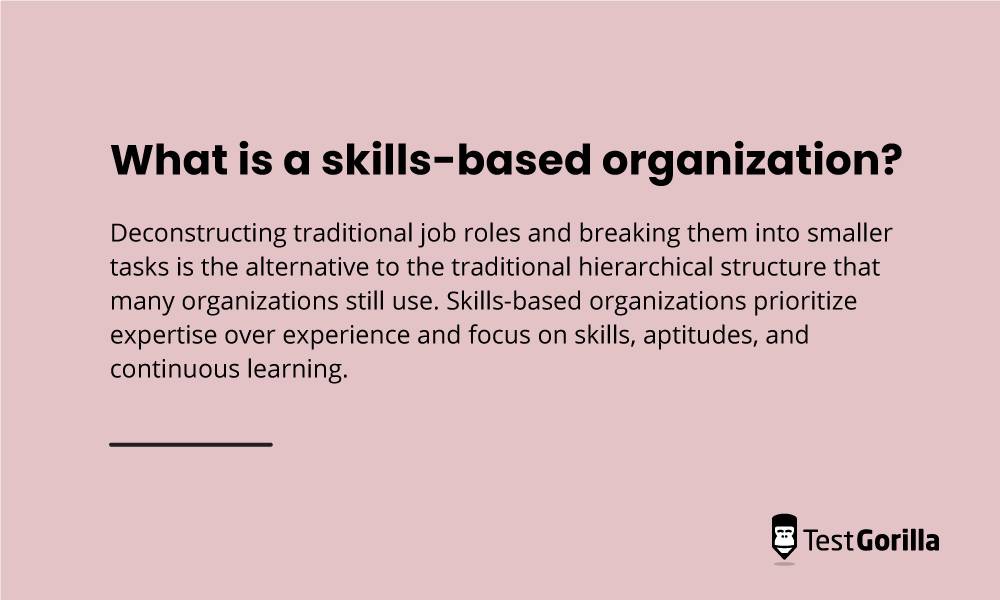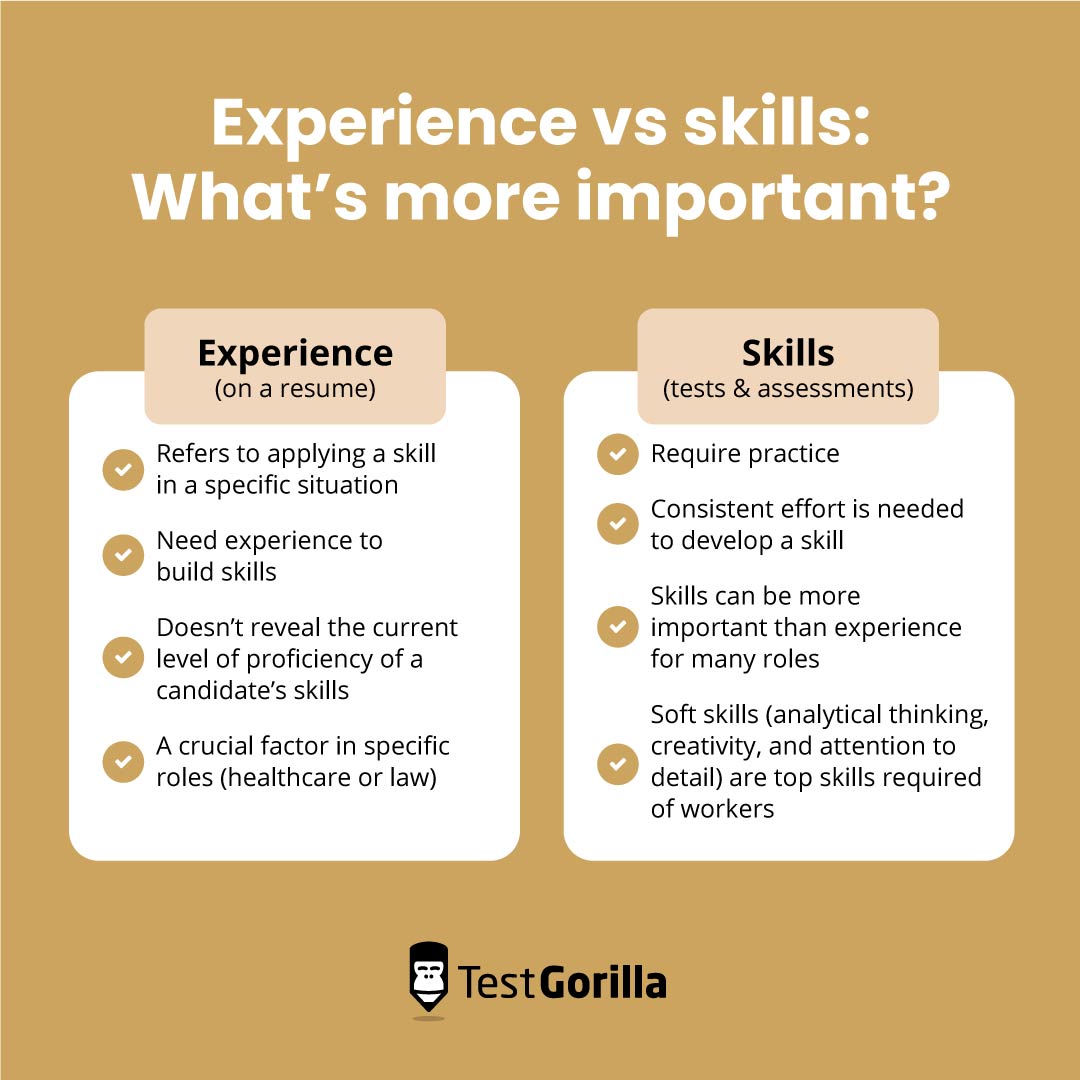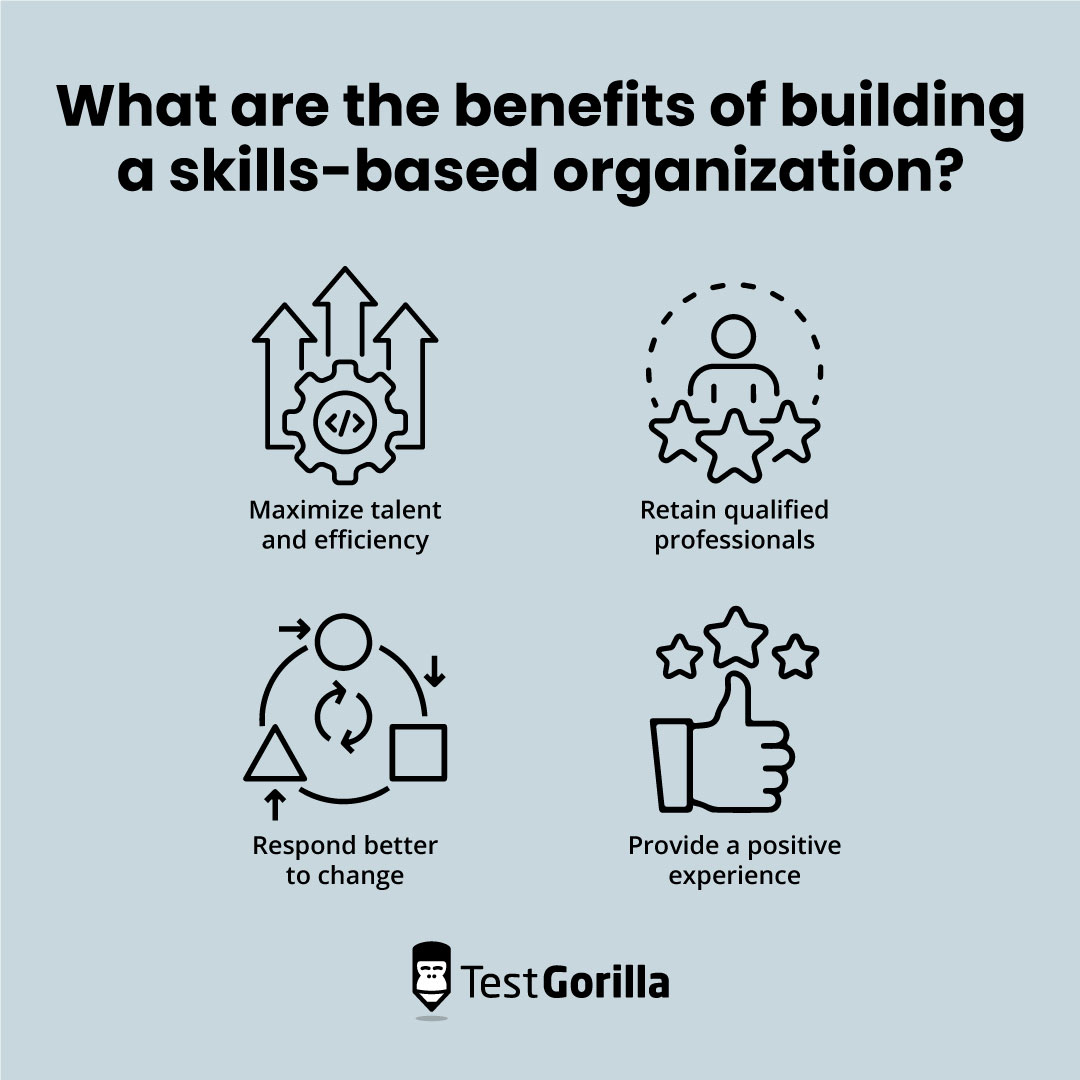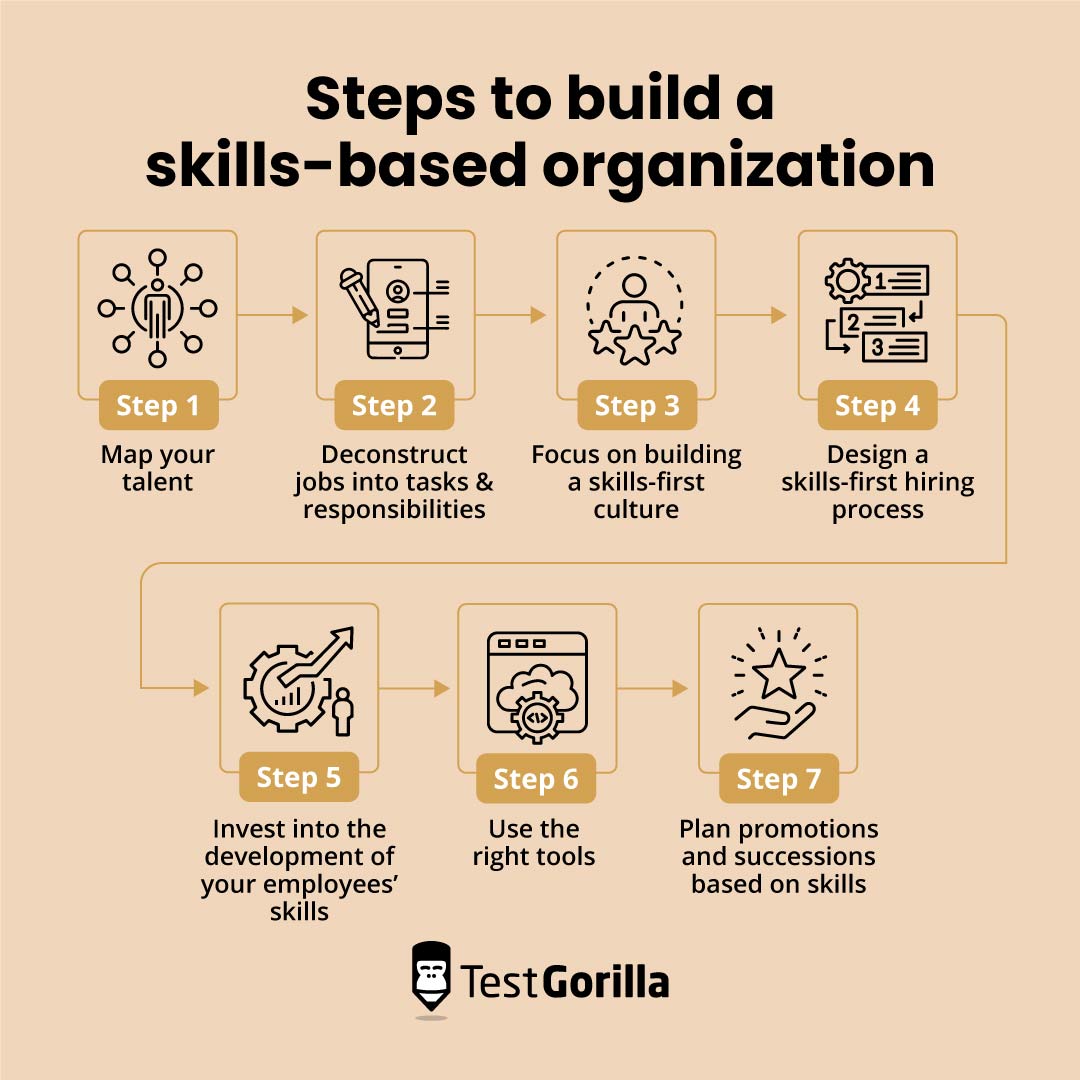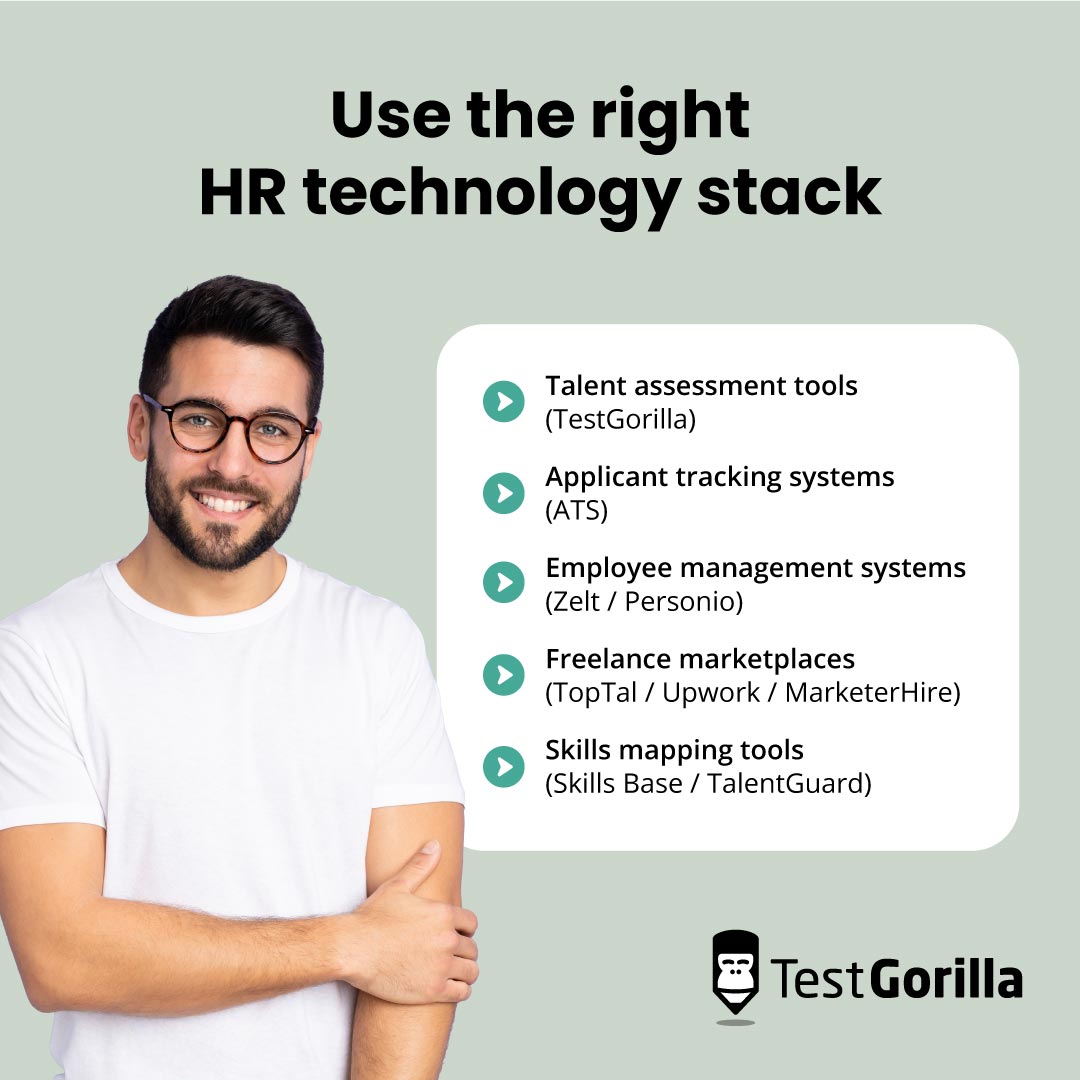How to build a skills-based organization: A step-by-step guide to success
In a world of disruption brought on by AI and worsening economic conditions, organizations’ survival depends on their capacity to transform and rethink every element of their operations.
And for this, rethinking the way you build and manage your most important asset – your team – is key. Therefore, transformation starts at the HR department: Reforming your hiring practices can lead to change and growth in every aspect of your business.
And in all this, the transition from a job-based mentality to a skills-based organization is a must, if you want to survive.
Skills-based organizations rethink traditional job roles and hire people based on the skills required for particular projects and tasks.
In this article, we are going to introduce you to the concept and benefits of skills-based organizations and explore the topic of experience vs skills.
Our seven-step quick guide to building a skills-based organization will help you develop a new, more agile approach toward hiring and operations management.
Table of contents
- What is a skills-based organization?
- What are the benefits of building a skills-based organization?
- The paradigm shift in hiring: From resumes to skills
- How to build a skills-based organization: A step-by-step guide to success
- Overcome talent shortages and build a more resilient organization with a skills-based approach
What is a skills-based organization?
The development of technology and the degree to which most processes can be automated nowadays leads to a rapidly changing work environment. When there are a lot of variables and opportunities for development, adaptability is more valuable than rigidness.
According to a Korn Ferry study, the demand for skilled workers will outstrip supply by 2030. Forward-thinking organizations are moving with the times and redefining their approach toward jobs.
Deconstructing traditional job roles and breaking them into smaller tasks is the alternative to the traditional hierarchical structure that many organizations still use.
Skills-based organizations prioritize expertise over experience and focus on skills, aptitudes, and continuous learning.
Skills-based organizations put people and their skills at the center. To do this, you need to ask yourself questions such as:
What are the tasks that need to be performed to achieve the company’s objectives?
What skills and aptitudes are essential to complete these tasks?
How can we identify the people who have the necessary skills?
How can we make sure we’re objective and impartial in our talent assessment?
Deloitte reports that 98% of business executives plan on incorporating a more skills-based approach. So, these are the questions you need to ask yourself if you want to build a skills-based organization and get with the times.
Experience vs skills: What’s more important?
People often use experience and skills interchangeably when talking about talent. However, it’s important to understand the difference between the two:
Skills require practice. To develop a skill, you need to put in consistent effort.
Experience refers to applying a skill in a specific situation.
This may sound as if a candidate who has experience is more skilled than one with no experience. Unfortunately, that’s not always the case.
While it’s true that you need some experience to build your skills, experience on a resume doesn’t always translate into having the right skills for a role.
There are some roles for which experience is still a crucial factor, for example, positions in healthcare or law. However, skills are more important than experience for many roles.
Here are three of the reasons why:
Your candidates’ experience doesn’t tell you about the specific situations in which they applied their skills, which may differ significantly from the ones that you need to hire them for
Experience on a resume doesn’t reveal the current level of proficiency of a candidate’s skills
As WEF reports, soft skills such as analytical thinking, creativity, and attention to detail rank first among the most in-demand skills in 2023. Experience can’t tell you much about your candidate’s soft skills.
What are the benefits of building a skills-based organization?
Building a skills-based organization comes with a multitude of benefits. Some of them are:
1. Maximize talent and efficiency
Skills-based organizations place talent in positions that correspond with their skills, not with degrees or previous experience. This increases performance – and also leads to happier employees.
It’s easier to discover hidden talent when you’re focused on the skills that your candidates demonstrate, rather than on qualifications. This also contributes to maximizing talent and efficiency.
Furthermore, skills-based organizations encourage cross-functional collaboration, which allows for a large improvement of many work processes.
2. Retain qualified professionals
Being able to retain top talent is a challenge for many organizations in this talent-driven era. Toxic culture is driving phenomena such as the Great Resignation, where a record 47 million people in the US quit their jobs in 2021. Workers are often dissatisfied with the lack of opportunities for upskilling and advancing their careers.
The team-based structure of skills-based organizations allows for more flexible job roles and many opportunities to work on different assignments. This contributes to building a happier workforce.
3. Respond better to change
Business priorities are rapidly evolving and the in-demand skills today can be different from the in-demand skills tomorrow.
Skills-based organizations who regularly use talent mapping make room for easier talent relocation, which improves your company’s response to change and disruptions and ensures that you can use the skills of your team members to adapt effectively to changing market conditions.
4. Provide a positive candidate and employee experience
Skills-based hiring helps unlock dream opportunities for candidates: According to our research, 90% of candidates say they are more likely to secure their dream job when given the chance to demonstrate their skills during hiring.
Adopting a skills-based approach directly correlates with employee happiness, too. In 2023, 55% of skills-based hires in IT were very happy in their roles, compared to only 17% of experience-based hires.
Why is this happening, though?
Pursuing meaningful and varied assignments and tasks and providing opportunities for growth make for satisfied employees. Satisfied employees make for increased productivity, motivation, and innovation. There is no thriving company without thriving employees.
The best insights on HR and recruitment, delivered to your inbox.
Biweekly updates. No spam. Unsubscribe any time.
The paradigm shift in hiring: From resumes to skills
Fears of an approaching economic downturn and the rise of AI-based tools that promise to revolutionize the world of work are forcing businesses to transform their approach to hiring.
Skills-based hiring has emerged as an alternative to rigid traditional hiring processes, in which resumes come first. Giving your candidates the opportunity to show their skills increases the likelihood of finding and hiring future top performers for your company.
The current job market is characterized by significant skills shortages, especially if you’re looking to hire on a local level. Skills-based hiring allows you to identify objectively and without bias talent from all over the world and to build a fair and cost-effective hiring process.
How? The world’s only annual report on skills-based hiring can help you find the answer to your questions about reinventing recruitment.
Read more on TestGorilla’s 2024 report on The State of Skills-Based Hiring if you want to find out why companies are starting to prioritize skills over experience and degrees – and what they’ve been able to achieve with the help of skills-based hiring. In short:
94% of employers agree that skills-based hiring is more predictive of job success than resumes
90% of businesses report improved employee retention when they started hiring for skills
60% of companies plan to increase their spend on skills-based hiring
Check out the report for the latest and most accurate data on skills-focused hiring.
How to build a skills-based organization: A step-by-step guide to success
To build a skills-based organization, you need to transform multiple aspects of your hiring process. Follow the steps in this guide to streamline the transition and make it go smoothly.
Step 1: Map your talent
Talent mapping is used to get a clear picture of your talent pool and define who is best suited for your job vacancy. Skills-based organizations heavily rely on talent mapping to build strategies to fill skills gaps.
Another use of talent mapping is to develop training programs for existing talent and help your employees grow professionally and be more efficient at work.
Talent mapping is a complex process but the two key steps that you need to focus on are to:
Identify your performance objectives clearly
Evaluate your candidates’ and employees’ skills accurately
To evaluate skills effectively for your talent map, it’s best to use different methods, such as:
Self-evaluation
360-degree feedback
Skills tests
A skills-testing platform like TestGorilla can help you build effective skills assessments that will allow you to evaluate your candidates’ aptitudes and skills without bias. They can be used to identify skills gaps and opportunities for growth for existing employees, as well.
Talent mapping is much easier when you have a way to collect data to support the process.
Step 2: Deconstruct jobs into tasks and responsibilities
Breaking down jobs into tasks reframes the talent shortage. Instead of seeking better candidates, offer better jobs.
To reconstruct the way you define job roles, try this:
Reframe your questions
Asking the right questions can lead you to the right answers.
So, next time you stumble across a hiring issue caused by talent shortage, don’t ask yourself “How do I find talent that can fit this job description?” When you’re using skills-based hiring, this question would sound like “What specific skills are essential for success in this role and where can I find people who have them?”
Adopting a different outlook can lead you to unexpected solutions for long-lasting dilemmas.
Divide & conquer
Unconventional ways to get things done are emerging; project-based, freelance, and gig work is on the rise.
Dividing the traditional jobs into smaller elements (projects, tasks, gigs) and identifying the skills necessary to do them will help you discover the right talent – including freelancers and independent contractors.
Isolate & reassign activities
The whole point of skills-based hiring is to reduce rigidity. If there is a particular activity in a job role that just doesn’t get done properly, don’t stubbornly insist that your employee is doing something wrong.
Sometimes, jobs evolve in a way that requires employees to spend a significant portion of time doing something that requires different expertise. Look into the matter and be agile enough to isolate and reassign particular tasks if necessary.
Step 3: Focus on building a skills-first culture
Good company culture is a key strategy for acquiring talent. It’s a combination of organizational values, behaviors, practices, and goals that has a strong impact on the way employees and management interact at work.
Company culture is a critical factor for the employee experience. It helps you:
Stand out among the competitors
Expand the talent pool
Attract passive candidates
Strengthen your brand
Skills-first culture focuses on the continuous development of employee skills. To develop a skills-first culture, you must identify skill gaps and invest time and resources in strategies to upskill and reskill your workforce.
Maintaining a strong learning and development function:
Guarantees a reliable and flexible workforce with in-demand skills
Inspires loyalty to your company
Increases employee satisfaction and reduces turnover
Makes your business more effective in turbulent times
Step 4: Design a skills-first hiring process
Skills-first hiring means focusing directly on skills, rather than on how they have been acquired. To design a skills-first hiring process, you must set aside the traditional method of screening resumes and relying on diplomas and qualifications.
Talent assessments will help you build an effective skills-first hiring process that empowers making data-driven decisions. Streamline your hiring process to make sure there is a right match between your candidates and your organization’s goals.
We recommend using different methods for talent assessment, such as:
Referrals
Work samples
Skills tests enable you to evaluate your candidates’ skills and compare their results so you can reduce the amount of candidates to interview. This shortens the amount of time and resources you spend on recruitment and helps you hire based on real data.
TestGorilla enables you to easily administer skills tests for each of your candidates, either by using the ones you can find in our extensive test library or by creating your own. You can also add open questions or ask your candidates for work samples.
Our skills tests cover a wide area of competencies, including:
Step 5: Invest into the development of your employees’ skills
Next, it’s time to put your money where your mouth is. Investing time and resources into the development of your employees’ skills is critical for any skills-based organization.
Training your workforce means you will get effective results and can feel confident that you can adapt when drastic change is necessary. On the other hand, your employees will be able to grow and develop professionally which leads to fulfillment and establishes a bond of trust.
Step 6: Use the right tools
To build a skills-based organization, you need to have the right HR technology stack. Here are some of our top suggestions:
Talent assessment tools that enable you to evaluate candidates’ and employees’ skills fairly and objectively, such as TestGorilla
Applicant tracking systems (ATS) that you can use to to build a smooth hiring process, such as Greenhouse or Workable (if you don’t have one yet, find out how to choose the best ATS)
Employee management systems to help you provide a stellar employee experience, such as Zelt and Personio
Freelance marketplaces to hire talent for fractional roles, such as TopTal, Upwork, and MarketerHire
Skills mapping tools that assist in visualizing and planning the skills landscape of your organization, such as Skills Base or TalentGuard
Step 7: Plan promotions and successions based on skills
Planning promotions and successions based on skills is a key component of building a skills-based organization. It enables you to:
Hire and promote inspiring leaders that other employees can look up to
Find the right people for every job role
Ensure the people in management and leadership roles have the necessary soft skills for the job
Motivate employees to develop, use, and demonstrate their skills
Create positive environment at work and provide a stellar employee experience
This is why it’s important to assess your employees’ skills consistently and keep track of their development.
Overcome talent shortages and build a more resilient organization with a skills-based approach
Businesses in the US and many other countries are facing a widening skills gap: They simply don’t manage to find the right talent for high-skilled positions. Thankfully, prioritizing skills can help you overcome the challenge of talent shortages and build a stronger, more resilient company.
Skills-based organizations are more diverse, perform better, and adapt faster to change. So, are you ready to future-proof yours?
Simplify the transition to a skills-based organization and develop a skills-first hiring process with the help of TestGorilla’s skills assessments.
Get started with our free plan today.
You've scrolled this far
Why not try TestGorilla for free, and see what happens when you put skills first.


